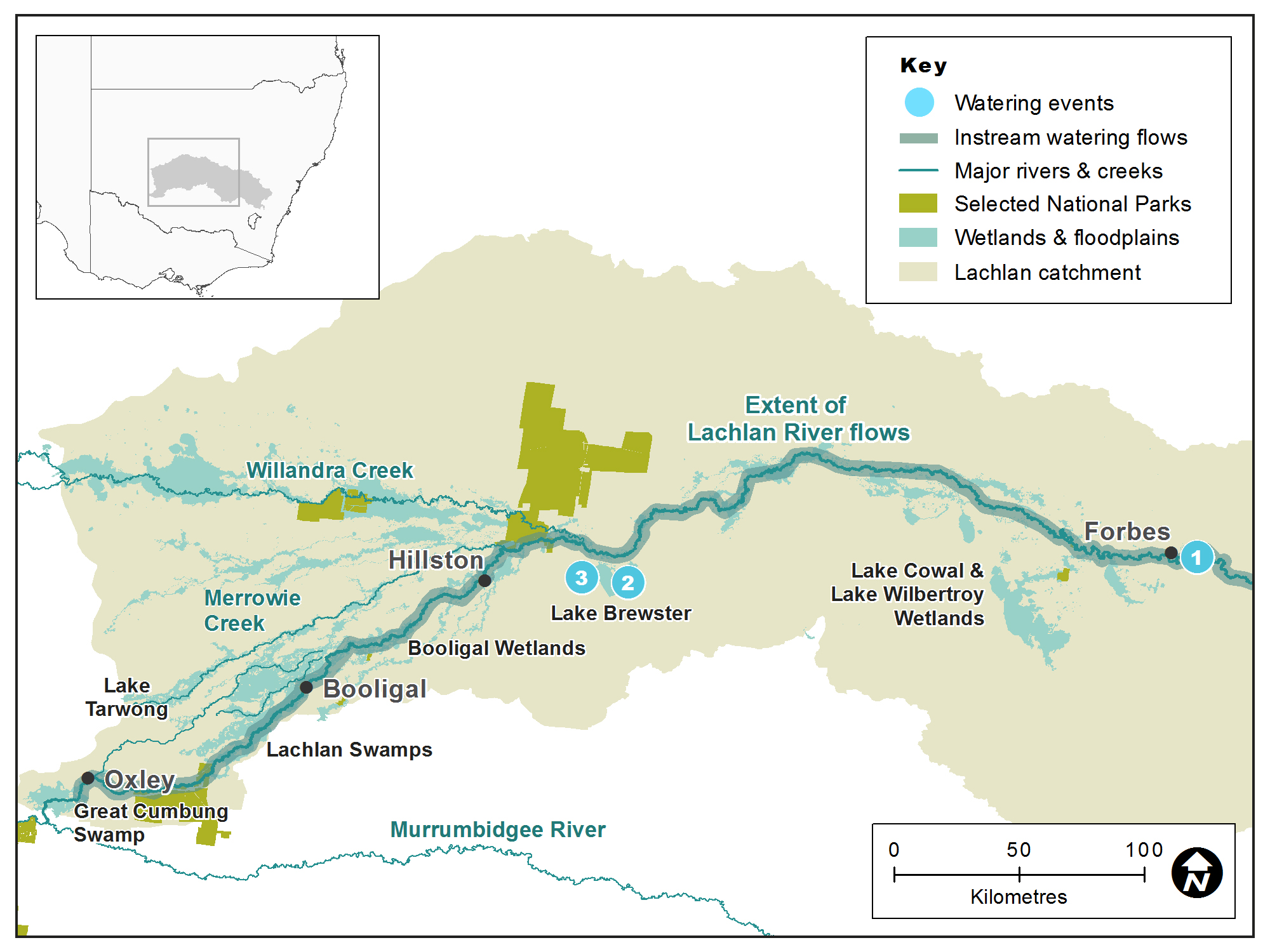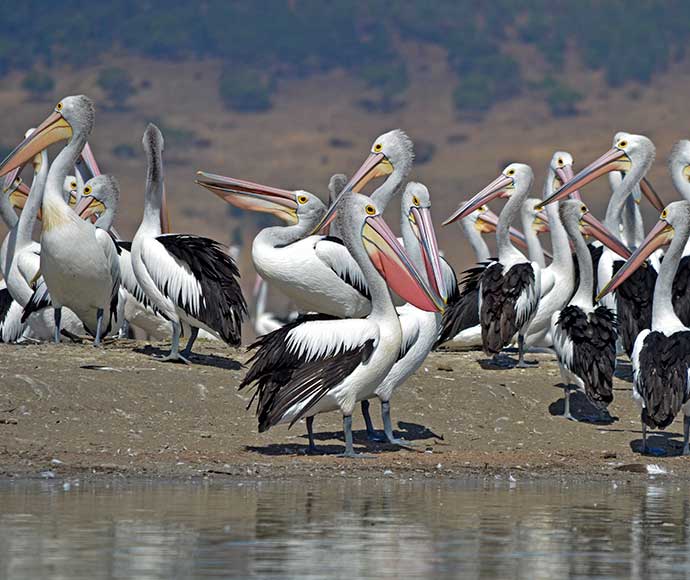In the Lachlan catchment, water for the environment was used to provide a series of flows from spring to winter in the 2017–18 water year targeting the full length of the Lachlan River. This:
- provided benefits for native fish populations
- delivered pulses of water into anabranch creeks
- supported successful wetland plant establishment
- supported a large pelican breeding colony at Lake Brewster
- supported riparian and wetland vegetation in the lower Lachlan
- stimulated frog and waterbird habitat recovery in the lower Lachlan.
It was a hot, dry year in the Lachlan catchment with no significant inflow into Wyangala Dam except for a short and intense inflow spike in December 2017. Water was carried over in accounts from the 2016 flood, although low inflows led to low allocations for all water users.

Map of the Lachlan catchment showing waterways, wetlands and locations of water for the environment deliveries made in 2017–18.
Watering aims
The Lachlan catchment began the 2017–18 year with access to carried-over water allocations because of high rainfall in the previous 12 months.
With hot, dry weather forecast, our water management team worked with the community-based Lachlan Environmental Water Advisory Group to determine short- and long-term priorities for use of the available water holdings.
Priorities identified for water deliveries were to:
- protect and enhance native fish populations within the river system by managing flows to support breeding, provide food, improve habitat and encourage movement
- support a pelican nesting colony at Lake Brewster to prevent nest abandonment, protect nesting sites from predators, improve availability of food and provide foraging and fledgling (swimming and flying) habitat
- plan targeted flows for the length of the river to ensure the release of nutrients throughout the system, boost the aquatic food web, support wetland plants including river red gums and black box, and provide food for waterbirds.
Water was re-used further downstream to target southern bell frog habitat and allow aquatic plants to re-establish before breeding season.
With the prospect of hot, dry weather ahead, we also focused on supporting refuge sites to sustain local wildlife through the warmer months.
Water delivery
This table provides a summary of water for the environment use in the Lachlan catchment during the 2017–18 watering year. Volumes are indicative only.
Notes: Location numbers in the table relate to watering events marked on the map.
NSW = NSW licensed environmental water; CEW = Commonwealth licensed environmental water; EWA = Environmental water allowance accrued under the Water Sharing Plan for the Lachlan Regulated River Water Source 2016.
| Watering event number | Location | Start date | Finish date | NSW | CEW | EWA | Total |
|---|---|---|---|---|---|---|---|
| 1 | Lachlan River fish flows | 27 Sep 2017 | 30 Jun 2018 | 33,523 | 9414 | 42,937 | |
| 2 | Lake Brewster pelicans | 11 Mar 2018 | 26 Mar 2018 | 2986 | – | – | 2986 |
| 3 | Lake Brewster wetland management and Autumn river pulse | 13 Nov 2017 | 15 Jun 2018 | – | – | 7881 | 7881 |
| Region | Total |
|---|---|
| NSW | 2986 |
| CEW | 33,523 |
| EWA | 17,295 |
| Total | 53,804 |
Outcomes
Native fish were the focus of managed watering events in the Lachlan catchment in 2017–18.
In collaboration with WaterNSW and the Commonwealth Environmental Water Office, OEH managed the delivery of 42,937 megalitres of water for the environment at key times throughout the year. This enabled fish to move and breed along the length of the Lachlan River.
To provide suitable flow conditions during the spring Murray cod spawning season, water for the environment was released to stabilise river levels between peaks of irrigation demand. Monitoring confirmed large numbers of small-bodied native fish such as Australian smelt and flat-headed gudgeon spawning. Repeat visits showed that larval size was generally increasing, indicating survival and growth.
As flows were delivered to the full run of the river below Wyangala Dam, seasonal pulses occurred into anabranch creeks maintaining habitat and opportunities for fish to move and access habitat and enhancing their connection with the Lachlan River. Freshwater catfish responded to a flow pulse in the Booberoi Creek.
Adaptive re-use of water already released for the environment to the Lachlan River and Lake Brewster, enabled the delivery of ‘freshes’ (or pulses of water) into the Booberoi Creek in spring and winter, and into the Lachlan River below Brewster to support fish populations into winter. When these flows arrived at the Great Cumbung Swamp, they partially inundated the reed beds, open water bodies and fringing wetland vegetation.
At Noonamah in the lower Lachlan, 41 megalitres of water for the environment that had already supported fish populations in the river below Brewster, was adaptively re-used. This water supported the continued recovery of a small black box wetland near Lake Bullogal where southern bell frogs were recently recorded for the first time in the Lachlan since the 1970s.
Waterbirds converged on the Noonamah black box swamp and the Great Cumbung Swamp after the arrival of water to take advantage of food resources associated with newly wetted ground and wading habitat.
Case study
A highlight from the year was the recovery of aquatic plants at the Lake Brewster outflow wetlands and a marked improvement in water quality as a result. Water for the environment provided the trigger for extensive beds of water milfoil, ribbon weed, rushes and water grasses to establish – the first time since the outflow wetlands were constructed.
OEH worked with WaterNSW to ensure water levels in the wetlands remained steady while plants established. Monitoring showed:
- improved dissolved oxygen levels
- improved water clarity
- lower levels of blue green algae in water leaving the wetlands compared with the main storage.
Lake Brewster remained operational throughout the summer irrigation season. This resulted in significant water savings as the Lachlan Water Quality Allowance was not required to cover the evaporative losses that usually arise from Lake Brewster being taken off-line.
Pelicans congregated at the site and began breeding at Lake Brewster in late summer 2017. Water for the environment (held and planned) was used to maintain water levels around nesting banks to protect nests and young from predation and to prevent nest abandonment. Over the course of the event around 4,500 nests were established and more than 3,000 young successfully fledged. This represents a successful fledging rate for pelicans.
Members of the Lachlan Environmental Water Advisory Group helped monitor the breeding event and researchers from the University of NSW undertook a second season of pelican banding.

Pelicans (Pelecanus conspicillatus) at Lake Brewster